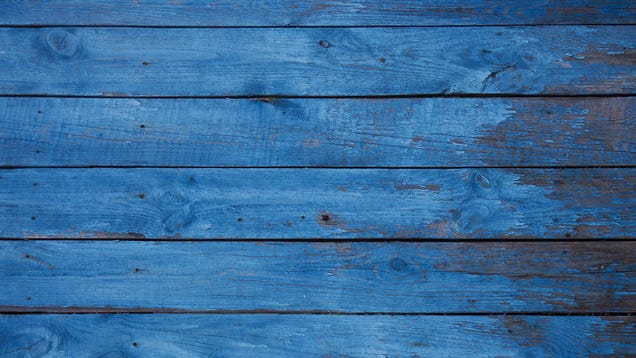
The first apartment I rented as a poor twenty-something had crappy wood floors that were painted brown, a fact I never much thought about until years later, after I bought my first house and had to tear some absolutely heinous green carpet up off our stairs. Underneath I discover pitted, cracked, and downright ugly treads underneath. I remembered those old painted floors, and painted our stairs, and suddenly saw my former landlord’s decisions in a whole new light.
For a lot of people, this sounds like sacrilege—the accepted wisdom is that hardwood flooring is beautiful, durable, and should be preserved at all costs. But you know what? Painting those stairs worked, and made me realize that painting wood floors isn’t always crazy. In fact, there are a few reasons why you might consider doing it in your own home.
Reasons to paint wood floors
There are fundamentally two reasons to paint a wood floor: Aesthetics and for more practical reasons. Let’s dig into both.
Aesthetics. Maybe you just like the look of painted floors. This is less crazy than you might imagine; as Remodelista notes, many charming cottages have painted floors—maybe you stayed in an adorable Airbnb once and loved the look of them.
But there are other reasons you might paint your floors for aesthetic effect:
- To hide imperfections. Natural hardwood is attractive, but can start to show its age. Gouges, pits, nailheads, stains—after a while a hardwood floor that is still in generally good shape can have inconsistent coloring and show lots of wear and tear. Some folks find that charming, a record of the lives lived on that floor. Others want a cleaner, more consistent look. A smooth coat of paint can hide all manner of problems.
- To tie together disparate wood types. If your home has several different floors, giving it a patchwork feel, painting all those different woods can tie everything together. This can be especially powerful if you want a consistent color palette and style throughout the home, because you can peg your furniture and decorations to a single floor color and look.
- To start with a clean slate. Wood floors are wood floors, and that can limit your design choices. Painting them, especially a light color—or even white—can make rooms feel bigger and brighter, and give you a lot more options when it comes to decoration.
G/O Media may get a commission

Up to $100 credit
Samsung Reserve
Reserve the next gen Samsung device
All you need to do is sign up with your email and boom: credit for your preorder on a new Samsung device.
Practicalities. On the other hand, maybe you’re not painting your floors because you love the look, but rather because of more practical considerations:
- To extend the life of the floor. If your hardwood floors have been refinished a few times, you might not be able to refinish them again. Engineered floors, for example, only have a thin veneer of hardwood on top, making sanding very tricky. And even solid hardwood can only be sanded 2-3 times before it starts to fail. Painting the floor gives it a fresh finish without an aggressive sanding. You’ll probably need to sand a bit to remove finish and egregious damage, but it will remove much less material than if you were sanding to refinish. Plus, a proper paint job will protect the floor from further erosion and damage.
- Costs. Put simply, refinishing hardwood floors can be pricey—anywhere from $2,400 to $6,000, depending on the size of your home and other factors. And installing new hardwood floors isn’t exactly cheap either, costing $12,000 to $36,000 for an entire house. Painting those floors will be much, much cheaper, so if you’ll looking to renovate without selling organs on the dark web, painting your floors is a good option.
What to consider before painting your wood floors
While there are good reasons to paint hardwood floors under the right circumstances, there are a few things to consider before you grab that half gallon of old paint from the garage and start slathering it around.
- You need the right materials. You can’t just use any old paint for your floors. You’ll need to prep the floors properly, select the right primer, and choose a super durable porch and floor enamel paint (or even marine paint, which will stand up to just about anything). The best paints for your floor may be very high in volatile organic compounds (VOCs), which can off-gas for long periods of time and have negative impacts on both the environment and your health.
- Think about permanence. While you can always repaint your floors a new color, if you paint your floors and hate the look it’s probably not possible to go back to plain old wood. This is especially true if you painted them because you couldn’t sand them down for a refinish in the first place.
- How will it wear? If you prime properly and choose a high-quality paint suitable for an interior floor you shouldn’t have too many problems with the paint wearing away—and maybe you like the scuffed charm of a patina. But unlike stained wood floors, paint sits on the surface and can wear away over time, or peel, chip, and crack. The good news is you can simply repaint every few years, but it’s a consideration.
- How will it affect your home value? You might love the look of your painted floors, and painting them may have given new life to some ragged hardwood. But not everyone will see it that way. If you ever intend to sell your home, consider that a lot of potential buyers will see painted floors as a big expense for them because they will have no choice but to tear them out and replace them.

0 Comments :
Post a Comment